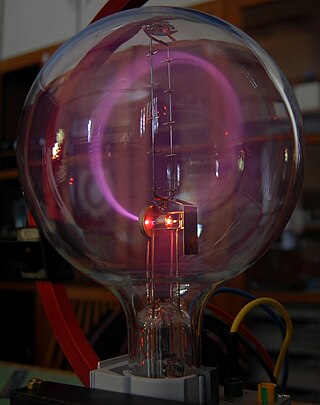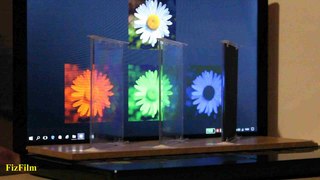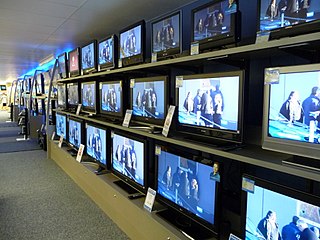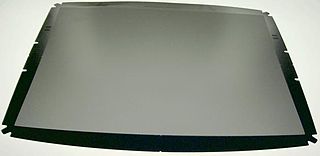This article includes a list of general references, but it lacks sufficient corresponding inline citations .(May 2020) |
Werner Flechsig (June 8, 1900 - October 12, 1981) was a German physicist and television pioneer.
This article includes a list of general references, but it lacks sufficient corresponding inline citations .(May 2020) |
Werner Flechsig (June 8, 1900 - October 12, 1981) was a German physicist and television pioneer.
Werner Flechsig was born on June 8, 1900, in Cologne, Germany. He began studying mathematics and physics at the Technical University of Hanover. He continued his education at the Georg August University of Göttingen. There, Flechsig assisted Robert Wichard Pohl. In 1925, Flechsig completed his doctorate with the dissertation "Science of Photoelectric Primary Current in Crystals." In this document, Flechsig dealt with hot cathodes and photocells. He also considered the work of Pohl assistant Bernhard Gudden.
Flechsig became an employee of Fernseh-AG in Berlin, where he developed TV camera tubes. In 1936, he made the orthicon technology practical. At the Olympic summer games, orthicon camera tubes supplanted the earlier iconoscope tubes.
In 1937, the Internationale Funkausstellung of the Reichspost Research Institute displayed a color television method. (The Internationale Funkausstellung is the International Radio Exposition.) The new color television method used two primary colors. The process failed to produce satisfactory pictures. Members of the organization discussed developing a more accurate method to produce a full-color display: Additive color mixing with three primary colors.
Flechsig invented the principle of color picture generation with shadow-mask picture tubes., [1] [2] He registered his shadow-mask process in July 1938 as a German Reichspatent. The patent title was "Cathode Ray Tube for the Development of Multicolored Pictures on a Fluorescent Screen." [3] An exhibit at the 1939 Internationale Funkausstellung Berlin displayed a prototype of Flechsig's color television receiver. [4]
The war put an end to technical implementation of Flechsig's shadow mask picture tube. The Radio Corporation of America produced the first commercial realization in 1949.
Flechsig was an honorary member of the Television and Cinema Engineering Society. Werner Flechsig died on October 12, 1981, in Wolfenbüttel.
Werner Flechsig: First Practical Color CRT, 1938
Internationale Funkausstellung Berlin, "History" section (IFA)IFA Berlin#History
The story of the shadow mask picture tubemask

A cathode-ray tube (CRT) is a vacuum tube containing one or more electron guns, which emit electron beams that are manipulated to display images on a phosphorescent screen. The images may represent electrical waveforms (oscilloscope), pictures, radar targets, or other phenomena. A CRT on a television set is commonly called a picture tube. CRTs have also been used as memory devices, in which case the screen is not intended to be visible to an observer. The term cathode ray was used to describe electron beams when they were first discovered, before it was understood that what was emitted from the cathode was a beam of electrons.

Cathode rays or electron beam (e-beam) are streams of electrons observed in discharge tubes. If an evacuated glass tube is equipped with two electrodes and a voltage is applied, glass behind the positive electrode is observed to glow, due to electrons emitted from the cathode. They were first observed in 1859 by German physicist Julius Plücker and Johann Wilhelm Hittorf, and were named in 1876 by Eugen Goldstein Kathodenstrahlen, or cathode rays. In 1897, British physicist J. J. Thomson showed that cathode rays were composed of a previously unknown negatively charged particle, which was later named the electron. Cathode-ray tubes (CRTs) use a focused beam of electrons deflected by electric or magnetic fields to render an image on a screen.

The RGB color model is an additive color model in which the red, green and blue primary colors of light are added together in various ways to reproduce a broad array of colors. The name of the model comes from the initials of the three additive primary colors, red, green, and blue.

Television (TV) is a telecommunication medium for transmitting moving images and sound. The term can refer to a television set, or the medium of television transmission. Television is a mass medium for advertising, entertainment, news, and sports.

The shadow mask is one of the two technologies used in the manufacture of cathode-ray tube (CRT) televisions and computer monitors which produce clear, focused color images. The other approach is the aperture grille, better known by its trade name, Trinitron. All early color televisions and the majority of CRT computer monitors used shadow mask technology. Both of these technologies are largely obsolete, having been increasingly replaced since the 1990s by the liquid-crystal display (LCD).

Trinitron was Sony's brand name for its line of aperture-grille-based CRTs used in television sets and computer monitors. One of the first television systems to enter the market since the 1950s.Constant improvement in the basic technology and attention to overall quality allowed Sony to charge a premium for Trinitron devices into the 1990s.
An electron gun is an electrical component in some vacuum tubes that produces a narrow, collimated electron beam that has a precise kinetic energy.

Video camera tubes were devices based on the cathode ray tube that were used in television cameras to capture television images, prior to the introduction of charge-coupled device (CCD) image sensors in the 1980s. Several different types of tubes were in use from the early 1930s, and as late as the 1990s.

A television set or television receiver, more commonly called the television, TV, TV set, telly, tele, or tube, is a large device that combines a tuner, display, and loudspeakers, for the purpose of viewing and hearing television broadcasts, or as a computer monitor. Introduced in the late 1920s in mechanical form, television sets became a popular consumer product after World War II in electronic form, using cathode ray tube (CRT) technology. The addition of color to broadcast television after 1953 further increased the popularity of television sets in the 1960s, and an outdoor antenna became a common feature of suburban homes. The ubiquitous television set became the display device for the first recorded media for consumer use in the 1970s, such as Betamax, VHS; these were later succeeded by DVD. It has been used as a display device since the first generation of home computers and dedicated video game consoles in the 1980s. By the early 2010s, flat-panel television incorporating liquid-crystal display (LCD) technology, especially LED-backlit LCD technology, largely replaced CRT and other display technologies. Modern flat panel TVs are typically capable of high-definition display and can also play content from a USB device. Starting in the late 2010s, most flat panel TVs began to offer 4K and 8K resolutions.

A Geissler tube is an early gas discharge tube used to demonstrate the principles of electrical glow discharge, similar to modern neon lighting. The tube was invented by the German physicist and glassblower Heinrich Geissler in 1857. It consists of a sealed, partially evacuated glass cylinder of various shapes with a metal electrode at each end, containing rarefied gasses such as neon, argon, or air; mercury vapor or other conductive fluids; or ionizable minerals or metals, such as sodium. When a high voltage is applied between the electrodes, an electrical current flows through the tube. The current dissociates electrons from the gas molecules, creating ions, and when the electrons recombine with the ions, the gas emits light by fluorescence. The color of light emitted is characteristic of the material within the tube, and many different colors and lighting effects can be achieved. The first gas-discharge lamps, Geissler tubes were novelty items, made in many artistic shapes and colors to demonstrate the new science of electricity. In the early 20th century, the technology was commercialized and evolved into neon lighting.

Mechanical television or mechanical scan television is an obsolete television system that relies on a mechanical scanning device, such as a rotating disk with holes in it or a rotating mirror drum, to scan the scene and generate the video signal, and a similar mechanical device at the receiver to display the picture. This contrasts with vacuum tube electronic television technology, using electron beam scanning methods, for example in cathode ray tube (CRT) televisions. Subsequently, modern solid-state liquid-crystal displays (LCD) are now used to create and display television pictures.

The IFA or Internationale Funkausstellung Berlin is one of the oldest industrial exhibitions in Germany. Between 1924 and 1939 it was an annual event, but from 1950 it was held every other year until 2005. Since then it has become an annual event again, held in September. Today it is one of world's leading trade shows for consumer electronics and home appliances.
The iconoscope was the first practical video camera tube to be used in early television cameras. The iconoscope produced a much stronger signal than earlier mechanical designs, and could be used under any well-lit conditions. This was the first fully electronic system to replace earlier cameras, which used special spotlights or spinning disks to capture light from a single very brightly lit spot.
The Chromatron is a color television cathode ray tube design invented by Nobel prize-winner Ernest Lawrence and developed commercially by Paramount Pictures, Sony, Litton Industries and others. The Chromatron offered brighter images than conventional color television systems using a shadow mask, but a host of development problems kept it from being widely used in spite of years of development. Sony eventually abandoned it in favor of their famous Trinitron system using an aperture grille.
The Geer tube was an early single-tube color television cathode ray tube, developed by Willard Geer. The Geer tube used a pattern of small phosphor-covered three-sided pyramids on the inside of the CRT faceplate to mix separate red, green and blue signals from three electron guns. The Geer tube had a number of disadvantages, and was never used commercially due to the much better images generated by RCA's shadow mask system. Nevertheless, Geer's patent was awarded first, and RCA purchased an option on it in case their own developments didn't pan out.
The beam-index tube is a color television cathode ray tube (CRT) design, using phosphor stripes and active-feedback timing, rather than phosphor dots and a beam-shadowing mask as developed by RCA. Beam indexing offered much brighter pictures than shadow-mask CRTs, reducing power consumption, and as they used a single electron gun rather than three, they were easier to build and required no alignment adjustments.

General Electric's Porta-Color was the first "portable" color television introduced in the United States in 1966.
Electrically operated display devices have developed from electromechanical systems for display of text, up to all-electronic devices capable of full-motion 3D color graphic displays. Electromagnetic devices, using a solenoid coil to control a visible flag or flap, were the earliest type, and were used for text displays such as stock market prices and arrival/departure display times. The cathode ray tube was the workhorse of text and video display technology for several decades until being displaced by plasma, liquid crystal (LCD), and solid-state devices such as thin-film transistors (TFTs), LEDs and OLEDs. With the advent of metal–oxide–semiconductor field-effect transistors (MOSFETs), integrated circuit (IC) chips, microprocessors, and microelectronic devices, many more individual picture elements ("pixels") could be incorporated into one display device, allowing graphic displays and video.
The following timeline tables list the discoveries and inventions in the history of electrical and electronic engineering.
375-line corresponds to two different electronic television systems, both using 375 scan lines. One system was used in Germany after 1936 along with the 180-line system, being replaced in a few years by the superior 441-line system. It was also tested in Italy around the same time.